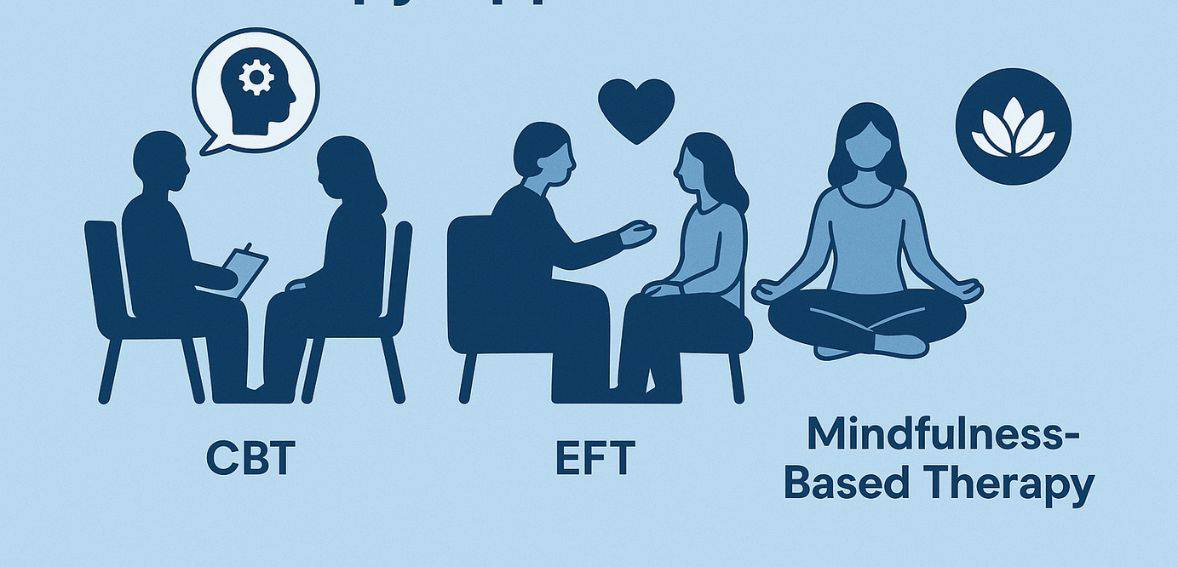
By richardtherapist September 3, 2025
It can be threatening to start therapy. With so many options, it’s normal to question which one will be most beneficial. Cognitive behavioral therapy (CBT), emotionally focused therapy (EFT), and mindfulness-based therapy are some of the most well-known and successful choices.
Each has its own philosophy and methods: mindfulness promotes acceptance and presence, EFT strengthens emotional ties, and CBT helps reframe negative thoughts. People can choose the strategy that most appeals to them by being aware of how these approaches vary and what makes them successful.
Examining these approaches not only offers insight but also shows how therapy can be customized to meet a range of needs, guaranteeing that healing is not only feasible but also extremely individualized.
Why Therapy Approaches Matter

There is no one-size-fits-all approach to mental health. The best kind of therapy varies, just as people differ in their personalities, upbringings, and ways of processing emotions—and even physical signals. After all, anxiety isn’t in your head; it often manifests physically, reinforcing the need for therapeutic techniques that honor both body and mind.
While one person may feel freed by finally expressing long-suppressed emotions in a safe environment, another may find strength in recognizing and replacing negative thought patterns. Learning to remain judgment-free and grounded in the present moment can benefit others. Because of these variations, it is essential to understand therapy techniques more thoroughly—not just in terms of definitions but also in terms of how they feel to use and experience.
Although each method has its own philosophy, resources, and methods, they all ultimately aim to assist people in leading more balanced, healthier lives. Exploring CBT, EFT, and mindfulness not only highlights the diversity of therapeutic options but also empowers individuals to make choices that resonate with their needs, values, and way of processing the world.
Cognitive Behavioral Therapy (CBT): Rewiring the Mind

One of the most popular and thoroughly studied types of therapy is cognitive behavioral therapy, or CBT. Basically, CBT works on the simple but potent principle that our thoughts have an impact on our feelings and behaviors. We can become stuck in cycles of anxiety, depression, or self-defeating behavior when our thoughts become distorted, excessively negative, or inflexible.
Identifying these thought patterns and questioning their veracity are common tasks in cognitive behavioral therapy sessions. For example, a person who suffers from social anxiety may think, “Everyone is judging me whenever I speak.”
In therapy, the patient and the therapist would analyze this idea, consider the supporting data, and consider more healthful, well-rounded alternatives, like “People are usually focused on themselves, not critiquing every word I say.” This reframing of perspective can significantly shift emotions and behaviors.
Because cognitive behavioral therapy is action-oriented, it encourages clients to practice new ways of thinking and acting in authentic circumstances rather than merely discussing issues. Common homework assignments include journaling, practicing relaxation techniques, or progressively confronting fears.
Healthy thought patterns become second nature as a result of this regular practice, which gradually helps rewire the brain. CBT is particularly appealing because it is goal-oriented and structured. CBT offers clarity and quantifiable progress for people who would rather use practical techniques than engage in open-ended conversations.
It works especially well for phobias, anxiety, depression, and even illnesses like chronic pain or insomnia. Although CBT is effective, some people may find it difficult to open up or find its logical structure too strict. For these people, methods such as EFT or mindfulness may feel more natural.
Emotionally Focused Therapy (EFT): Healing Through Connection

Emotionally Focused Therapy (EFT) focuses on the heart, specifically how people establish and preserve emotional bonds, whereas Cognitive Behavioral Therapy (CBT) examines the mind through thoughts and behaviors. EFT was first created for couples, but it has since been extended to families and individuals. Its basis is attachment theory, which examines how people yearn for security and closeness in their most intimate relationships.
Finding emotional needs and expressing them in ways that enhance rather than erode relationships are common themes in EFT sessions. For instance, in couples therapy, one partner may become angry, but not out of hatred, but rather out of fear of being ignored or abandoned. To reveal the underlying emotions, EFT assists in removing these protective layers.
Couples frequently transition from cycles of conflict to cycles of intimacy and support by embracing vulnerability. This strategy aims to change the way people emotionally interact with one another, not just improve communication skills. EFT places more emphasis on building a solid emotional foundation than it does on solving problems. People are more likely to develop, heal, and connect authentically when they feel safe, understood, and validated.
EFT has proven to be very successful for families attempting to regain trust as well as for couples dealing with infidelity, separation, or ongoing conflict. Additionally, it can be helpful in individual therapy, particularly for people who have trouble expressing their emotions, have attachment wounds, or fear abandonment. In contrast to CBT, which might appeal to reason, EFT resonates with those who are driven by feelings, relationships, and the desire for closeness.
Mindfulness-Based Therapy: Living in the Present

Mindfulness has developed into a powerful therapeutic tool that goes beyond a wellness fad. Breathing exercises, meditation, and mindful awareness techniques are all incorporated into the healing process through mindfulness-based therapy. Basically, mindfulness teaches people to be judgment-free in the present, paying attention to thoughts and feelings as they come up rather than automatically responding to them.
This may involve teaching someone who suffers from anxiety how to sit with racing thoughts without allowing them to become panicked. Mindfulness promotes observing depressive symptoms without being drawn into them. This exercise gradually raises self-awareness and weakens the hold of automatic negative thinking.
Two structured approaches that are frequently employed in clinical settings are Mindfulness-Based Cognitive Therapy (MBCT) and Mindfulness-Based Stress Reduction (MBSR). These methods provide a link between traditional talk therapy and meditation by fusing mindfulness exercises with therapeutic techniques. Body scans, guided meditation, and activities that foster acceptance and compassion are all possible in a session.
The holistic advantages of mindfulness-based therapy are what make it so lovely. It frequently improves sleep, reduces stress, and improves general well-being in addition to reducing the symptoms of anxiety and depression. Many people experience a change in perspective as a result of it; they stop avoiding or fighting difficult emotions all the time and learn how to live with them more healthily.
Despite not being as relational as EFT or as structured as CBT, mindfulness provides something just as beneficial: the capacity to find stillness, clarity, and self-acceptance in everyday life.
Comparing the Approaches: Choosing What Fits
While it’s critical to understand the differences between CBT, EFT, and mindfulness, the true question is how an individual determines which approach is best for them. The answer frequently depends on how they personally process emotions as well as the type of difficulties they face.
For example, CBT might work best for someone who needs structure, likes hands-on activities, and has specific goals. EFT’s emphasis on vulnerability and bonding may resonate with a person or couple dealing with emotional disconnection, relational wounds, or attachment fears. In the meantime, mindfulness-based therapy may be helpful for people who experience stress overload, recurrent negative emotions, or a sense of detachment from the present.
Therapy, of course, is rarely about choosing a box and sticking with it. In order to customize sessions to meet the needs of each client, many therapists incorporate components from various approaches. Mindfulness techniques may be incorporated into a CBT framework, or cognitive rephrasing of thoughts may be part of an EFT-based session. This adaptability guarantees that therapy is responsive rather than inflexible, adjusting to the individual’s path.
The Human Side of Therapy

At its core, therapy is about people, regardless of the various approaches, tools, and philosophies. It is about someone feeling supported, heard, and seen in ways that they may not have previously experienced. The true healing frequently originates from the therapeutic relationship itself, whether it is through sharing vulnerabilities in EFT, rephrasing thoughts in CBT, or developing awareness in mindfulness.
The client-therapist relationship, trust, and empathy can be just as effective as the methods used. Selecting therapy is about finding a path forward, one step at a time, rather than trying to find the ideal solution overnight. For others, it might mean learning to express love more openly or to breathe more calmly when life feels overwhelming. What matters most is the willingness to begin and the openness to grow.
Finding the Right Fit in Therapy
Choosing a therapy approach is rarely about labels or technical definitions—it’s about finding a method that speaks to your unique experiences and needs. While Cognitive Behavioral Therapy, Emotionally Focused Therapy, and Mindfulness-Based Therapy may sound like structured systems, they are ultimately tools to help people feel understood, supported, and empowered.
Some people are drawn to the practical, step-by-step guidance of CBT, while others need the emotional depth offered by EFT, or the calm grounding that mindfulness provides. Each path opens a different door toward healing, but all share the same goal: helping people live with greater balance, clarity, and resilience.
As therapy evolves, clients increasingly explore digital platforms for support—training their minds via guided exercises or tracking mindfulness practices. For those evaluating tools like Mindbody, a Mindbody Online review can help determine if it supports your personal healing journey, whether you’re blending CBT routines with mindfulness or scheduling EFT sessions.
Conclusion
Mindfulness-based therapies, EFT, and CBT all provide unique and effective approaches to healing. CBT focuses on changing thought patterns to affect mood and behavior. The foundation of healing, according to EFT, is emotional ties and connection. Living in the present with awareness and acceptance is encouraged by mindfulness-based therapy. Regardless of using different approaches, they all aim to assist people in living more resilient, peaceful, and clear lives.
Understanding these methods can help make the process a little easier, even though selecting the best therapy may require time, trial, and error, and reflection. Finding a strategy that feels encouraging, speaks to individual needs, and promotes development is what really counts. Finding healthier, more satisfying ways of living is the goal of therapy, not just problem-solving.